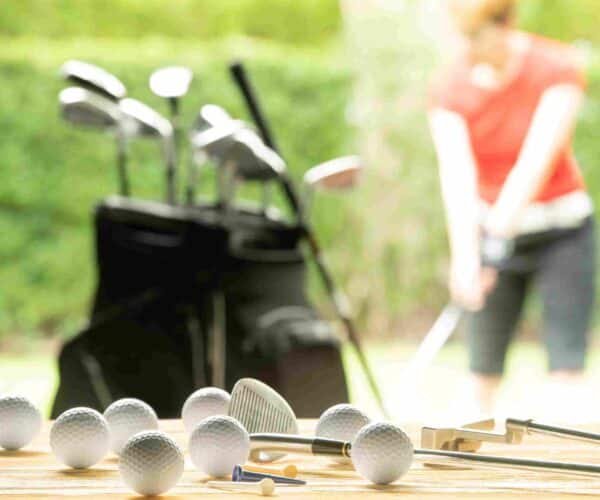Golf is a game of precision, where every small detail can impact your performance. Despite this, many golfers still play with clubs that aren’t suited to their individual swing, build, or style of play. Considering what you might spend on a new set of golf clubs, it’s much like investing in a high-end road bike—you want to make sure the equipment works for you and delivers the best possible return on your investment.
Poorly fitted clubs can hinder your game in more ways than one. From inconsistent ball striking to reduced distance and even physical discomfort, the wrong equipment can make the game more frustrating than it needs to be. Yet, surprisingly, a large number of golfers still don’t take advantage of professional club fitting services, often due to misconceptions about who it’s for or concerns about cost.
Whether you’re new to the sport or a seasoned player, having clubs tailored to your swing can significantly improve your consistency, performance, and confidence. In this guide, we’ll explore what a golf fitting is, the benefits it offers, where to get fitted, and whether it’s a worthwhile investment for your game.
What is a golf club fitting?
A golf club fitting is a process that ensures your clubs match your swing characteristics, physical attributes, and playing style. A professional fitter assesses various factors, including your swing speed, launch angle, spin rate, and stance, to recommend clubs with the right specifications. These adjustments can include shaft type, club length, lie angle, grip size, and loft.
The goal is to optimise your equipment so that you can play with greater ease and efficiency, ultimately lowering your scores and enhancing your overall experience on the course.
What are the benefits of custom fit golf clubs?

Many golfers assume that club fittings are reserved for professionals, but they are available to all and could be a game-changer. A custom fitting ensures that your clubs complement your natural swing rather than forcing you to adjust to ill-fitting equipment. This results in better accuracy, improved shot consistency, and enhanced comfort. A well-fitted set of clubs can also reduce strain on your body, helping to prevent injuries caused by poor posture or excessive effort to correct mishits.
When comparing off-the-shelf clubs to custom-fitted ones, the difference in performance can be remarkable, making the fitting process worthwhile for golfers of all levels.
Key benefits include:
Enhanced accuracy on shots
Improved shot-to-shot consistency
Increased comfort during play
Reduced risk of injury
Equipment tailored to your physical attributes and swing
Greater confidence on the course
Potential for lower scores and better overall performance
Where can you get a golf club fitting?

Golf club fittings are widely available, but it’s worth noting the different types of providers and what to look for when booking a session. Many golf retailers and pro shops offer fitting services, often in partnership with major manufacturers. Independent fitting studios, however, provide an unbiased approach, ensuring you get clubs based on your needs rather than sales priorities. Some golf courses also have fitting professionals on-site, allowing you to test clubs in real playing conditions. Here’s a breakdown of your options:
Golf retailers and Pro shops
Many high street and online golf retailers offer fitting services, often run in collaboration with major golf brands. These locations typically have access to the latest club models and brand-specific fitting tools. They can be a convenient choice, especially for golfers looking to try equipment from a particular manufacturer. However, it’s worth noting that recommendations may sometimes be influenced by sales goals or limited product selections, so it’s important to ask questions and be clear about your priorities.
Independent fitting studios
Independent studios focus solely on the fitting process, providing an unbiased service that prioritises your needs over brand allegiance. They usually offer a wide variety of clubs from different manufacturers and invest in state-of-the-art technology to deliver detailed swing analysis. With no ties to specific brands, their recommendations are often more tailored and objective, making them an excellent choice for golfers seeking a fully customised experience.
On-course fitting services
Some golf courses have professional fitters on-site or host regular fitting events. These services can be particularly helpful because they often allow you to test clubs in real playing conditions rather than just in a simulator. Being able to hit from turf and see the actual ball flight can give you greater confidence in the equipment you choose.
Manufacturer fitting days
Major golf brands frequently organise fitting days at local clubs or driving ranges. These events are a fantastic way to try out the latest models under the guidance of brand-trained fitters. However, since the focus is limited to that brand’s equipment and time slots may be short, these sessions are best suited for players already interested in a specific manufacturer.
What to look for in a fitter
When choosing a fitter, it’s wise to consider their credentials, the technology they use, and their reputation. Look for professionals with training or accreditation from trusted golf organisations or manufacturers. The best fitters use modern tools like launch monitors, high-speed cameras, and pressure mats to gather accurate data. Lastly, check online reviews or ask fellow golfers for recommendations to ensure you select someone with a proven track record of delivering quality service.
The cost of a golf club fitting – Is it worth it?
The cost of a golf club fitting can vary depending on how comprehensive the session is and how many clubs you want to have fitted. For example, a full bag fitting might range from £100 to £300, while more focused fittings, such as for a driver or putter, typically cost between £50 and £100. At first glance, this might seem like a significant outlay, especially when added to the cost of purchasing new clubs.
However, without a fitting, golfers often buy clubs based on brand loyalty, guesswork, or trial and error, which can lead to costly mistakes. Investing in a fitting ensures you’re buying equipment that’s right for your game, potentially saving money by avoiding the need to replace unsuitable clubs later on.
Ultimately, while a fitting does come with a price tag, many golfers see it as a worthwhile investment. It’s not just about improving your equipment; it’s about maximising the value of your purchase and getting the most out of your time on the course.
What to expect during a golf club fitting

A golf club fitting is a detailed and personalised experience. Here’s a breakdown of what typically happens during a session:
Duration
- A fitting session usually lasts between 60 to 90 minutes.
- The length depends on how many clubs you’re having fitted (e.g. full bag, just driver, or putter).
Initial Consultation
- The session begins with a conversation about your current game.
- You’ll discuss your goals, playing style, and existing equipment.
- This helps the fitter understand your needs and expectations.
Swing and Performance Analysis
- Advanced tools are used, such as launch monitors, high-speed cameras, and pressure mats.
- These capture data like swing speed, ball flight, launch angle, and spin rate.
- The analysis provides insights into your natural swing characteristics.
Club Specification Recommendations
- Based on the data, the fitter suggests optimal club specifications.
- This can include shaft flex, club length, lie angle, loft, and grip size.
- The goal is to match the club to your physical build and swing style.
Testing Club Combinations
- You’ll try various combinations of club heads and shafts.
- Testing helps you feel and see the difference between setups.
- The fitter observes both the data and your feedback to fine-tune recommendations.
Final Recommendations
- By the end of the session, you’ll receive detailed recommendations.
- These will outline the best-suited clubs tailored to your game.
- Some fitters may even provide a printout or email summary for reference.
A professional fitting not only enhances your equipment but also builds your confidence and enjoyment on the course.
Myths and misconceptions about golf club fittings
Despite the benefits, some myths persist about golf club fittings. Let’s look at some of the most common misconceptions:
Fittings are only for professionals or low-handicap players
One common misconception is that fittings are only necessary for professional or low-handicap players. In reality, mid and high-handicap golfers can benefit just as much, if not more. Properly fitted clubs can help correct common swing flaws, making the game more enjoyable and improving overall performance.
Fittings are too expensive
Another myth is that fittings are prohibitively costly. While there is an upfront cost, a fitting can actually save money in the long run by helping you avoid purchasing unsuitable clubs. A well-informed purchase is often more cost-effective than trial and error.
All fittings are the same
Some golfers believe that all fitting sessions offer the same experience. However, the quality of the fitter and the technology used can make a significant difference in the outcome. A comprehensive, data-driven fitting with a qualified professional can deliver much better results than a basic or brand-limited session.
Understanding and challenging these myths can help more golfers see the value in investing in a proper club fitting, regardless of skill level or budget.
How often should you get fitted for golf clubs?

A golf club fitting isn’t just a one-time event. Over time, your swing can change due to improvements in technique, age-related adjustments, or even injuries. As a rule, it’s a good idea to get fitted every two to three years or whenever you experience significant changes in your game.
Signs that you may need a new fitting include inconsistent ball striking, loss of distance, or feeling uncomfortable with your clubs. Regular fittings ensure that your equipment continues to support your best possible performance.
A golf club fitting is one of the most effective ways to improve your game, regardless of your skill level. If you’re serious about golf, a professional fitting could be the key to unlocking your full potential and enjoying the game even more. So, why not book a session and see the difference for yourself?
Get Golf Insurance from SportsCover Direct
A quality set of golf clubs, especially when custom-fitted, represents a significant investment, often totalling hundreds or even thousands of pounds. Given the value of this equipment and the risk of theft, loss, or accidental damage, having specialist golf insurance is essential.
SportsCover Direct’s golf insurance is designed to protect you, your financial wellbeing, and your equipment. If you cause injury or damage to another person during a round of golf, our cover includes legal fees and any necessary damage payouts. Additionally, there’s cover for up to £250 of clubhouse drinks if you land a hole-in-one.
Our policy also gives the option of up to £7,500 of protection against equipment theft, loss and damage; just choose your preferred level of cover. Plus, our Personal Accident cover offers protection for potential legal and medical expenses in the unfortunate event of accidentally causing injury or property damage.
Find out more and get a quote tailored to your needs. Contact our team if you have any questions.
This blog has been created as general information and should not be taken as advice. Make sure you have the correct level of insurance for your requirements and always review policy documentation.